Abstract
The usage of Electric Vehicles (EVs) for transportation is expected to continue growing, which opens up new possibilities for creating new smart grids. It offers a large-scale penetration of Fast Charging Stations (FCE) in a local utility network. A severe voltage fluctuation and increased active power loss might result from the inappropriate placement of the FCE as it penetrates the Distribution System (DST). This paper proposes a multi-objective optimisation for the simultaneous optimal allocation of FCEs, Distributed Generators (DGs), and Shunted Capacitors (SCs). The proposed Pareto dominance-based hybrid methodology incorporates the advantages of the Grey Wolf Optimiser and Particle Swarm Optimisation algorithm to minimise the objectives on 118 bus radial distribution systems. The proposed method outperforms some other existing algorithms in terms of minimising (a) active power loss costs of the distribution system, (b) voltage deviations, (c) FCE development costs, (d) EV energy consumption costs, and (e) DG costs, as well as satisfying the number of FCEs and EVs in all zones based on transportation and the electrical network. The simulation results demonstrate that the simultaneous deployment technique yields better outcomes, such as the active power loss costs of the distribution system being reduced to 53.21%, voltage deviations being reduced to 68.99%, FCE development costs being reduced to 22.56%, EV energy consumption costs being reduced to 19.8%, and DG costs being reduced to 5.1%.
1. Introduction
Climate change is one of the major concerns due to the enormous discharge of greenhouse gas because of the burning of fossil fuels. Carbon dioxide is one of the leading greenhouse gases responsible for a rising global temperature. Many countries are taking serious steps to curb the carbon footprint, such as renewable energy [1]. Renewable energy is essential to a power system’s environment and energy economy. Replacing conventional combustion fuel with Electric Vehicles (EVs) is an economical and viable way to change [2,3]. Many nations have fixed the goal of 100% EV penetration in the future [4]. Due to this trend, the demand for FCEs and DGs in the DST is rising. The utility operators use SCs to improve the voltage profile in the distributed system. The improper allocation of FCE, DGs, and SCs negatively impacts the performance of DST. The proper distribution of FCEs and renewable energy sources could reduce barriers to EV adoption on a large scale and make sure that users of EVs can quickly obtain FCE [5].
Many researchers have stressed the impact and complexities of EVs on the distribution system [6,7,8]. Different models are developed [9,10,11,12] to reduce the uncertainties caused by EV mobility and to enhance environmental and economic benefits. By promoting this FCE infrastructure, with less worry about running out of power, EVs might travel more considerable distances. Existing studies consider power supply and transportation while preparing for the rising penetration of FCE. The operating and capital costs should be considered when planning FCEs on the power supply side [13]. Additional complexities could be introduced by EV’s rapid loading traits [14,15] and battery health [16,17]. Fahmy et al. [18] developed electric grid generic topologies where charging stations are connected to solve the challenges of EV aggregators. Yufei Wang et al. [19] suggested a setup strategy for flywheel energy storage systems for FCE. Regarding transportation, FCE’s location must allow for an extensive and efficient travel service because it is a capital-intensive part of the transportation network [20]. Aside from that, the planning paradigm has also considered individual PEV drivers’ mobility when using an acceptable spatial and temporal resolution [21]. L Bitencour et al. [22] developed a methodology where the semi-fast charging station is placed optimally in the neighbourhood. Dong et al. [23] developed a strategy for pricing FCEs to control voltage. Wang et al. [24] investigated the problem of FCEs in a highway with constraints such as budget and service capacities using a Bat Algorithm (BA).
Even while the power supply and transportation were addressed independently in previous works, FCE placement design necessitates the simultaneous consideration of these issues. Ignoring one or the other could result in poor economic choices, and even issues with the operation of the Transportation System (TN) or the electrical grid. For instance, placing an FCE near the feeder’s head may be beneficial for reducing power delivery losses. However, due to geographical limitations, EV drivers might find it harder to reach this area. Xiang et al. [25] considered FCE’s operational and investment costs, taking traffic restrictions into their planning models. In order to ensure that the entire road network’s route is serviced by at least one FCE, the research by Miljanic et al. [26] sought to determine the least amount of strategically placed charging stations using an Integer Linear Programming Technique (ILP). For the best positioning and sizing of the FCE, Sadeghi et al. [27] introduced a Mixed-Integer Non-Linear (MINLP) optimisation approach. The proposed approach considers various factors, including the cost of station development, EV-specific energy, power grid loss, the placement of electric substations, and urban roadways.
The planning model used in the above articles has merely assigned the FCE, a frequent trait. At the same time, introducing EVs into the power grid may increase the energy loss, voltage drop, and peak load. In the literature, DGs are used as a planning tool to reduce the voltage drop and energy loss caused by the addition of the EV charging demand to the grid. Placing the FCE and DGs in the distribution system is covered by several research methods. Ajit et al. [28] proposed a model to place the FCE and DGs to reduce the distribution system’s power loss and the cost of installing FCE. Battapothula et al. [29] suggested a model that minimises the network power loss and FCE installation cost as multi-objective optimisation problems to assign the FCE and DGs. Injeti et.al. [30] explained how optimally DGs could be integrated into EVs in the distribution system with an enhanced voltage profile system and decreased losses with a Butterfly Optimisation (BF) technique. Kumar et al. [31] developed a two-level framework. Regarding the first level of DST, DGs have been positioned optimally to reduce active power loss. The second level’s optimal energy usage was carried out for the first level’s location. Chang et al. [32] proposed a microgrid model that includes EVs. A renewable source powers charging stations. M. Ghofrani et al. [33] developed a framework where EVs and DGs are integrated into the DST based on operation and market aspects. Ahmad et al. [34] designed a framework for EMS for public EVs charging stations, integrating the microgrid depending on the market scenario. Rahmani-Andebili et al. [35] investigated the problems of DISCOs, i.e., the allocation of grid-based parking and management of an EV fleet.
In the literature cited above, DGs, which include solar panels, fuel cells, and microturbines, are described as an electrical source of energy that produces electricity at a unity power factor. SCs are utilised in distribution systems to meet reactive power requirements, where the power factor is improved. P Rajesh et al. [36] developed a methodology for the optimal allocation of the EV charging station in the presence of a capacitor, which enhances the DST’s voltage profile and reduces power loss. Biswas et al. [37] discussed the advantages of metaheuristic methods for determining the size and location of DGs and SCs in the DST to reduce the active power loss. Bilal et al. [38] presented that the optimal placement of the FCE and the capacitor reduces power loss and enhances the voltage profile of the DST.
Due to the relevance of FCE placement, significant literature on the subject has been published recently. Much of this research aims to minimise investment costs, transportation costs, energy loss, and voltage deviations, which can be accomplished using evolutionary algorithms such as Particle Swarm Optimisation (PSO) [39], Grey Wolf Optimisation (GWO) [40], JAYA algorithm [41] and Non-dominated sorting genetic algorithm-II (NSGA-2) [42]. Akanksha et al. [43] used the multi-objective GWO technique to identify non-dominated solutions and fuzzy satisfaction-based decisions to get at the final planning of FCE. Singh et al. [44] suggested a novel hybrid form that uses the advantages of both GWO and PSO. The primary goal of development is to increase the effectiveness for both types by strengthening the exploratory and exploitative capabilities of GWO and PSO.
Most authors cover the optimum placement of the FCE [6,7,8,9,10,11,12,13,14,15,16,17,18,19,20,21,22,23,24,25,26,27] or FCE and DGs [28,29,30,31,32,33,34,35] together. Few researchers consider the best placement of FCE, DGs, and SCs [36,37,38]. Voltage deviations (DVT), the development cost of the FCE (DFC), the cost of DGs (DGC), and the energy consumption of EV users are not discussed in those studies. In this study, the road network was integrated with a DST and placed optimally for FCE, DGs, and SCs simultaneously to minimise the active power loss costs of the distribution system (CPDN), DVT, FCE development costs (DFC), EUC, and DGC. Table 1 summarises the research gap analysis and the authors’ contributions.

Table 1.
An overview of the authors’ work and the research gap analyses.
The following list outlines the paper’s contribution step by step:
- 1.
- The optimal placement of the FCE and number of EVs considering active power loss, EV user behaviour, and DST voltage profile.
- 2.
- DGs’ optimal sizing and location consider the FCE load to minimise real power loss and enhance DST’s voltage profile.
- 3.
- Optimal placement of SCs considers the FCE load and DGs to improve the voltage profile of DST.
- 4.
- Simultaneous optimum placement of FCE, DGs, and SCs, considering EV user behaviour, real power loss, and DST voltage profile.
The remainder of this paper is structured as follows: Section 2 explains the formulation of the multi-objective issue and associated limitations. Section 3 presents the suggested hybrid GWO-PSO algorithm for the system under consideration. In Section 4, the results and analysis are covered. Section 5 discusses conclusions.
2. Problem Formulation
This section includes objective operations, such as DFC, EUC, CPDN, DVT and DGC being minimised.
In order to determine the optimal allocation of FCE, the proposed approach uses an arbitrary area, as depicted in Figure 1. Zones [45,46] are created inside the research area, such as , and , where the number of EVs is available in each zone [29]. The assumption is that the number of EVs in each zone is located in the geographical centre. On a particular day, it was assumed that the FCE charges the Total Number of EVs () in the considered area. is calculated as:
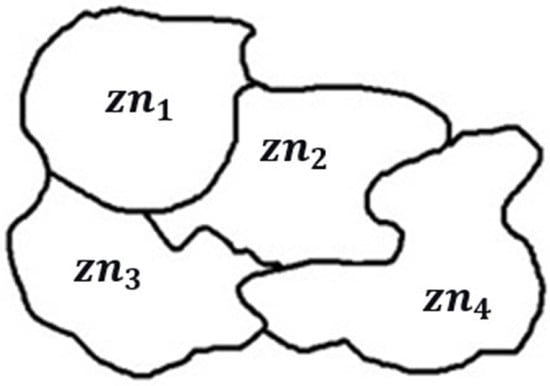
Figure 1.
Illustrative zones with area.
The number of committed in the zone () is represented by the value .
2.1. Development Cost of FCEs (DFC)
includes the cost of the charging station equipment and land cost. The equipment and land cost of charging station is a function of the number of charging connectors and capacity of charging stations [27].
FCE’s fixed cost is denoted by (USD). Since it deals with the equipment, the cost is almost similar among the different countries. (in USD per meter) is the land rental cost yearly. The study time for the FCE consists of years. The charger development cost is , is the number of connectors in charging stations in the ith FCE, and is the charging connector rated power (kW).
The probability that EVs will be charged in an hour (h) during a day is . is a decision binary variable, and if EVs in the are charged in the ith FCE, then ; otherwise, it is zero. The choice of EVs in the to the ith FCE is calculated by the minimal distance between the ith FCE to compared to the other FCE.
The capacity of the charging station’s connectors differs between 50–250 kW. The rating of the ith FCE is calculated as:
2.2. Energy Consumption of EVs User Cost (EUC)
The EV user takes a particular route to reach the FCE. While driving, the EV consumes energy, and the cost related to energy consumption is represented by the . In order to charge the batteries of EVs, which are situated at location zone to the nearest ith FCE, is calculated as [27]:
The distance between the ith and zone () on a trajectory length is denoted as . The electricity price in USD is represented by , and CSE is the specific energy consumption of EVs. EVs’ CSE stands for their specific energy consumption.
2.3. Active Power Loss of Distribution Network Cost (CPDN)
Since the EV demand is increasing, the load in the distribution network increases and distribution network power losses also increase. A non-linear relationship exists between the loading and the distribution network loss. The load varies from hour to hour on a particular day and during the year. A correct estimation of the distribution network power loss due to EV charging is required, i.e., the load variation must be considered. The Active power loss of the Distribution Network Cost () [27] of all seasons in a year is calculated as:
The number of seasons is denoted as , and TPL is the active power loss of the DST, including EV loads. The total number of hours throughout all seasons in a year is .
2.4. Cost of DGs (DGC)
The cost of DGs includes the cost of investment , the cost of operation , and the cost of maintenance of DGs [29].
- 1.
- Cost of Investment: this includes various initial costs, such as money invested on unit construction, essential equipment, and installation for each generation unit. This cost can be expressed as:
- 2.
- Cost of operation: the generation cost, fuel cost, and other similar costs are considered in the cost of operation . It can be formulated as
- 3.
- Cost of Maintenance: This includes the cost required for restoring the unit equipment, renewal, and repairing.
Hours in a year are denoted by . The number of DGs considered for this study is , with being the total years for DG planning. Lastly, the can be determined as:
2.5. DVT
The improper placement of the FCE and DGs in the DST leads to voltage instability. This work calculates voltage deviations for 24 h of all seasons. Calculating the of DST is as follows:
The voltage of the jth bus is , and the DST bus number is .
2.6. Objective Problems
The optimum number of FCEs obtained using the proposed optimisation procedure is denoted by the symbol . The primary purpose of the objective problem is to minimise the , , , , and by satisfying the constraints.
Constraints
To recharge the EVs from the research area, one FCE must be installed.
is a binary decision variable; if the kth FCE is chosen, ; otherwise, . is the number of feasible FCEs. At least one connector should be taken into account from the chosen FCE.
One optimal FCE is chosen by EVs from each depending on the displacement between to the kth FCE.
3. Overview of Hybrid GWO-PSO Algorithm
In the real world, the power system has multiple objective functions that should be optimised simultaneously. The objective function suggested in this work is optimised using a hybrid GWO-PSO technique [44]. The best features of GWO and PSO are combined to solve the problems. PSO [39] is a population-based metaheuristic optimisation algorithm. The greatest advantages of PSO is that it is simple to perform and has fewer controlling parameters.
Here, is the position vector, is the velocity vector, is the iteration, p is the particle in the population, w is the inertia of the weight parameter, is the best position in the pth particle and is the best position in the available population. In the PSO algorithm, the main disadvantage is that the updated position and velocity of a particle cannot jump into another space with a global optimum and has a low convergence rate in the iterative process.
Grey Wolf Optimisation (GWO) [40] is an intelligent swarm technique. GWO follows the hierarchy of leadership. Grey wolves are well coordinated and always live in packs. They always follow the social hierarchy, and, based on this hierarchy, they can be classified into four types of wolves, i.e., Alpha , Beta , Delta , and Omega . This social hierarchy is based on their fitness value. is the top leader and makes the decisions (hunting, staying in one place, sleeping, etc.), and other members follow the order. is subordinate to , where helps give suggestions to for decision making and always ensures that other members follow the order given by . is subordinate to but superior to . is the follower and occupies the minuscule level in the hierarchy.
3.1. Encircling the Victim
During hunting, they encircle the prey. Encircling mathematical behaviour is modelled as
denotes the current iteration, depicts the location of the prey, and Z represents the positioning of the grey wolf. It is possible to determine the vector coefficients and as
[0, 1] are the boundaries of the random vectors . Through iterations, the coefficient linearly declines from 2 to 0.
3.2. Hunting Procedure
provides direction for the hunting process. A deeper understanding of the prey (optimal solution) is held by , , and . As alpha, beta, and delta change positions, other wolves in the back update the positions. Attacking can be expressed mathematically as follows:
3.3. Exploring and Attacking a Victim
When wolves attack their prey, and , the R-value should fall between [−2r, 2r]. Exploitation is the act of attacking prey. Exploration is the process through which they separate to look for the target. If , wolves are compelled to look for prey.
3.4. Hybrid GWO-PSO
Singh et al. [44] used low-level co-evolution mix hybrids for hybridising GWO with the PSO method. This algorithm’s design philosophy integrates the GWO algorithm’s exploration capability with the PSO algorithm’s exploitation capability to maximise both types’ strengths. The exploration and exploitation of the grey wolves in the search area are controlled by the inertia constant (w) rather than conventional mathematical calculations. The suggested equations update the positions of the first three agents in the search space.
By revising the velocity and locations’ equations as below, the GWO and PSO variants are combined.
Figure 2 depicts the hybrid GWO-PSO algorithm’s flowchart. The hybrid GWO-PSO process’ basic steps are as follows:
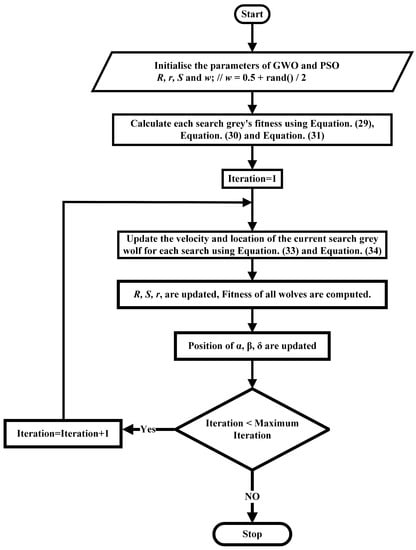
Figure 2.
Hybrid GWO-PSO flowchart.
- 1.
- Initialise the parameters of GWO and PSO , , and w; // w = 0.5 + rand()/2 and set maximum iteration.
- 2.
- 3.
- 4.
- , , and , are updated, Fitness of all wolves are computed.
- 5.
- Positions of , , and are updated
- 6.
- Until the terminating requirements are met, repeat this process.
The multiple objective functions are constructed as a single goal function by selecting appropriate weights for each objective in all traditional approaches, such as the weighted objective approach. There are primarily two issues with determining the single objective’s optimal value. The first is that while optimising a single objective function might ensure the existence of a single optimal solution, in all practical uses, the judgement still wants access to other solutions. The second examines how each goal in a single objection function responds to its weights. Additionally, the classical approaches are ineffective when the objective function is much noisier, and the factors in the search area are discontinuous.
Multi-objective Pareto front optimisation techniques are required to address multi-objective scenarios to get around the abovementioned issues. The hybrid methods are also quite effective at locating the best solution. In this work, hybrid GWO-PSO was utilised to meet the desired objectives. Mirjalili et al. [47] proposed a set of non-dominated solutions, and one of these solutions must be chosen by the decision maker. Due to the subjectively inaccurate nature of the decision maker’s assessment and the fact that it is straightforward to employ and has similarities to human thinking, the fuzzy satisfaction-based method [43] was employed in this case for ultimate decision-making.
4. Results and Discussion
In this study, four scenarios with various cases were explored using the suggested test system to determine the optimum distribution of FCE, DGs, and SCs in a connected transportation network.
4.1. Proposed Methodology
This study used a 720 km2 test area to apply the suggested strategy [29]. The population of EVs in each research area zone is shown in Figure 3. There are 180 zones in the test area, each with a . As seen in Figure 4, a test area was connected to the 118 bus radial distribution system [29].

Figure 3.
Zone EV population.
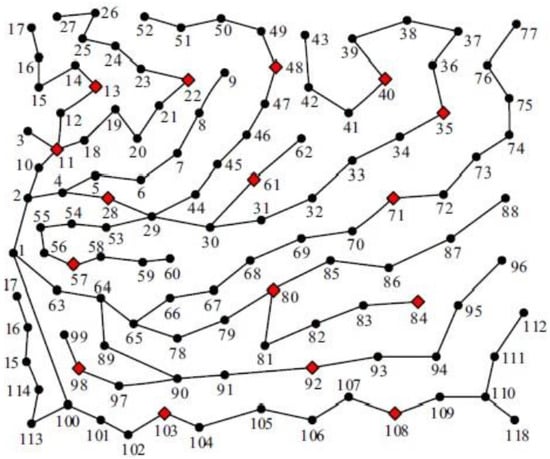
Figure 4.
118 bus distribution system in the proposed testing area.
In this paper, the total EV population was considered as 1632. With the requirement that each FCE is roughly equally spaced apart, it has been assumed that 16 FCE might be put along the test area’s major roadways. Figure 4 depicts 16 possible FCEs represented in the DST by the rhombus symbol. The simulation of the proposed problem was carried out in MATLAB 2017a software installed on a computer with a processor intel core i5 8th Gen and 8 GB RAM. A 118 distribution bus system was considered to carry out the analysis. The distributed system’s base values were as follows: 22.71 MW of real power, 11 kV, 100 MW, and 1.7041 MVAr [29]. The load curve [27] for different seasons is shown in Figure 5. For the optimum location and sizing of DGs and SCs in the distribution system, this paper considered five bus nodes of DGs units and three bus nodes of SCs units. From 5 a.m. to 9 p.m. every day, it is presumable that EVs are charged at the FCE. Figure 6 indicates the probability of daily EV charging. The DST and FCE parameters are represented in Table 2. Four different scenarios were analysed with the help of a hybrid GWO-PSO algorithm with a maximum of 500 iterations for appraising the proposed problem.
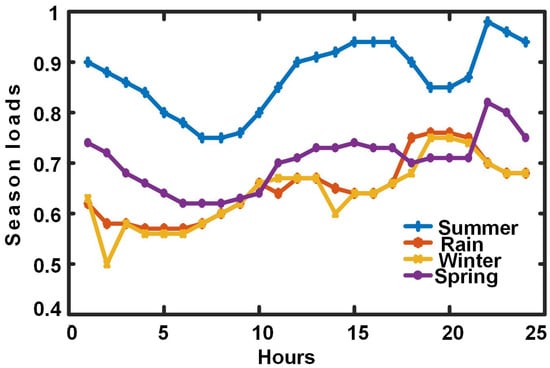
Figure 5.
Load curve on an hourly basis for various seasons.
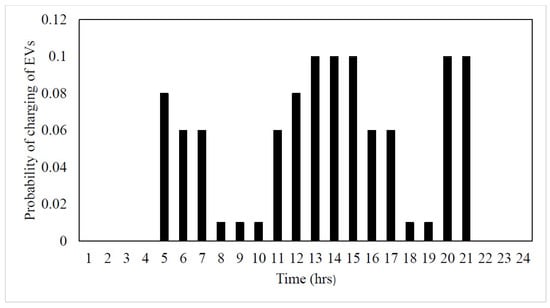
Figure 6.
EVs’ probability of being charged.

Table 2.
Study parameters.
Due to its simple and independent structure from the problem, an optimisation method utilised in planning FCE, DGs, and SCs can be applied to any test system. Additionally, the fuzzy satisfaction-based choice approach [43] allows decision makers to select the ultimate organising strategy under their preferences by selecting preferred values.
4.2. Scenario 1: Optimum Placement of FCE in DST Conjunction with Transportation Network
The optimal allocation of an FCE is achieved by minimising the EUC, CPDN, and DVT of the DST. DGs are not considered; therefore, DGC in Equation (12) is zero. Since the total number of connectors in FCEs is almost constant, the DFC variation has an almost negligible effect on the objective function. Thus, the DFC is not considered to minimise the objective function in this scenario. In this scenario, three cases are taken:
- (a)
- Case 1: Minimisation of EUC and CPDN.
- (b)
- Case 2: Minimisation of DVT and CPDN.
- (c)
- Case 3: Minimisation of DVT, CPDN, and EUC.
The optimal Pareto font for various cases in scenario 1 shows figures from Figure 7a–c. The best location and size of the FCE are obtained from the fuzzy satisfaction-based choice approach [43]. Table 3 displays the optimum FCE position and EV values, whereas Table 4 displays the optimal objective parameters.
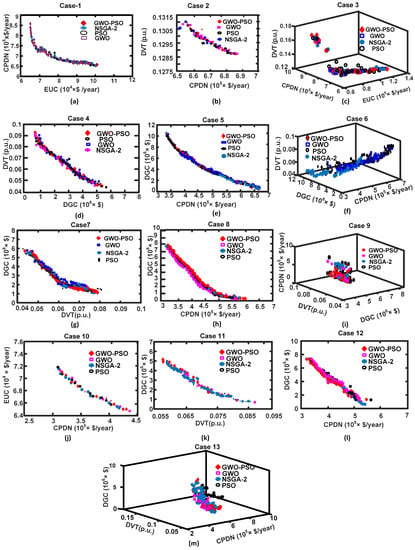
Figure 7.
Optimal Pareto-front.

Table 3.
The optimum FCE location and the optimum number of EVs.

Table 4.
Objectives of scenario 1 that are optimal.
4.3. Scenario 2: Optimal Positioning of DGs in DST with Previous Optimum FCE Load
DGs enhance the voltage profile and lower power losses in the DST. For the optimal DGs positioning, the optimal FCE load from case 3 is taken into account. This scenario takes into account three cases.
- (a)
- Case 4: Minimisation of DGC and DVT.
- (b)
- Case 5: Minimisation of CPDN and DGC.
- (c)
- Case 6: Minimisation of DGC, DVT, and CPDN.
Figure 7d–f are displayed using the best pareto-front for various scenarios in scenario 2. The optimal location and size of DGs are obtained from the fuzzy satisfaction-based choice approach. For various cases in scenario 2, the optimum location and sizing of DGs are displayed in Table 5, and objective parameters are depicted in Table 6.

Table 5.
Scenario 2: Optimal location and sizing of DGs.

Table 6.
Objectives of scenario 2 that are optimal.
4.4. Scenario 3: Allocation of DGs and SCs in DST Optimally Using the Previous Optimal FCE Load
The optimal positioning of DGs and SCs is considered in the distributed system to enhance the voltage profile of the system. Three cases are used in this scenario for the optimal planning of DGs and SCs with the optimum load of the FCE from case 3.
- (a)
- Case 7: Minimisation of DGC and DVT.
- (b)
- Case 8: Minimisation of CPDN and DGC.
- (c)
- Case 9: Minimisation of DGC, DVT, and CPDN.
The optimal pareto font for various cases in scenario 3 shows figures from Figure 7g–i. The optimal location and size of DGs and SCs are obtained from the fuzzy satisfaction-based choice approach. For various cases in scenario 3, the optimal sizing and location of DGs are shown in Table 7, Table 8 shows the optimal SCs position and sizing, and Table 9 shows the objective parameters.

Table 7.
DGs’ optimal location and sizing for scenario 3.

Table 8.
Optimal location and sizing of SCs for scenario 3.

Table 9.
Scenario 3’s optimal objective parameters.
4.5. Scenario 4: Simultaneous Optimum Location and Sizing of FCE, DGs, and SCs in DST
In this scenario, the optimum location and sizing of the FCE, DGs, and SC in a DST is achieved by coupling a transportation network to reduce the cost of CPDN, EUC, DGC, and DVT. The following four cases are considered.
- (a)
- Case 10: Minimisation of CPDN and EUC.
- (b)
- Case 11: Minimisation of DGC and DVT.
- (c)
- Case 12: Minimisation of CPDN and DGC.
- (d)
- Case 13: Minimisation of DGC, DVT, and CPDN.
The optimal Pareto font for various cases is scenario 4, which shows figures from Figure 7j–m. The best location and size of FCE, DGs, and SCs are obtained from the fuzzy satisfaction-based choice approach. For various cases in scenario 4, the optimal allocation of the FCE, number of EVs, DGs, and SCs is shown in Table 10, Table 11 and Table 12. The objective is the parameters that are shown in Table 13.

Table 10.
Optimal FCE location and EVs optimal numbers in scenario 4.

Table 11.
Optimal positioning and sizing of DGs for scenario 4.

Table 12.
Optimal positioning and sizing of SCs for scenario 4.

Table 13.
Scenario 4’s optimal objective parameters.
Table 14 compares the outcomes of four scenarios. Hybrid GWO-PSO outperforms other algorithms in terms of performance. In case 13, the DVT decreased by 68.99%, 18.8%, and 4.8% in comparison to case 3, case 6, and case 9. In case 13, the CPDN decreased by 53.21%, 22.41%, and 7.68% in comparison to case 3, case 6, and case 9. The DGC is reduced to 5.1% and 1.7% in case 13 in comparison to cases 6 and 9. Similarly, the DFC and EUC were reduced to 22.56% and 19.8% in case 13 compared to all cases. Simultaneous optimal FCE, DGs, and SCs in the coupled DST and road network give the best economical solution for the proposed method.

Table 14.
Four scenarios’ comparison results.
5. Conclusions
This paper proposes a multi-objective hybrid GWO-PSO algorithm for the simultaneous optimal planning of fast charging stations, distributed generators, and shunt capacitors in an integrated electric transportation system. The problem was formulated to minimize the objectives, such as the cost of the active power loss of the distribution network, the development cost of the FCE, EV user energy consumption cost, voltage deviations, and cost of DGs on an 118 bus distribution system. Various case studies regarding the individual stage-wise placement and simultaneous placement of fast charging stations, distributed generators, and shunt capacitors using the proposed method were performed. They showed that the proposed method outperformed the stage-wise placement of various components in terms of the reduced active power loss cost and reduced EV user cost, and maintained a better voltage profile. The hybrid GWO-PSO method yields a better profit via simultaneous optimal allocation than the stage-wise placement for an equivalent investment on charging stations and DGs. The amalgam GWO-PSO algorithm proves to be robust and reliable when compared with conventional algorithms. The present work can be extended with vehicle-to-grid technology.
Author Contributions
Conceptualisation, A.K.M. and S.R.S.; methodology, A.K.M., P.S.B. and S.R.S.; software, A.K.M.; validation, A.K.M. and P.S.B.; review and editing, A.K.M., P.S.B. and S.R.S. All authors have read and agreed to the published version of the manuscript.
Funding
Woosong University’s Academic Research Funding—2022.
Institutional Review Board Statement
Not applicable.
Informed Consent Statement
Not applicable.
Data Availability Statement
Not applicable.
Conflicts of Interest
The authors declare no conflict of interest.
Abbreviations
The following abbreviations are used in this manuscript:
| EVs | Electrical Vehicles |
| FCEs | Electric Vehicle Fast charging stations |
| DST | Distribution System |
| DGs | Distributed Generators |
| SCs | Shunt Capacitors |
| CPDN | Active power loss of distribution network cost |
| DVTs | Voltage Deviations |
| DFC | Development Cost of FCE |
| EUC | Energy Consumption of EV user cost |
| DGC | Cost of DGs |
| GWO | Grey Wolf Optimiser |
| PSO | Particle Swarm Optimisation |
| NTEV | Total number of EVs |
| TLBO | Teaching-Learning-Based Optimisation |
| TPL | Total power loss of the distribution network including EV load |
| TGL | Gross power loss of the distribution network without EV load |
| TNL | Transportation network without EV load |
| Total number of committed EVs in zone | |
| Number of zones in the assumed study area | |
| The fixed cost of charging stations | |
| Land rental cost yearly | |
| Development cost of chargers | |
| Number of years in the study period | |
| Number of connectors in charging stations in the FCE period | |
| Probability of the charging of EVs in hour (h) in a day | |
| Charging connector rated power | |
| Trajectory length between zone zn and the FCE | |
| Specific energy consumption of EVs | |
| Electricity price in dollars | |
| Number of seasons | |
| Total number of hours of all seasons in a year | |
| d | Index of DG |
| Active power generated by unit | |
| Cost of investment of each unit | |
| Cost of investment | |
| Cost of operation | |
| Cost of maintenance | |
| Number of hours in a year | |
| Total number of years for the planning of DGs | |
| Number of DGs | |
| Bus number of the distribution system | |
| Voltage of bus | |
| Number of FCEs | |
| Number of possible FCEs |
References
- Amin, A.; Tareen, W.U.K.; Usman, M.; Ali, H.; Bari, I.; Horan, B.; Mekhilef, S.; Asif, M.; Ahmed, S.; Mahmood, A. A review of optimal charging strategy for electric vehicles under dynamic pricing schemes in the distribution charging network. Sustainability 2020, 12, 10160. [Google Scholar] [CrossRef]
- Mirzapour, F.; Lakzaei, M.; Varamini, G.; Teimourian, M.; Ghadimi, N. A new prediction model of battery and wind-solar output in hybrid power system. J. Ambient Intell. Humaniz. Comput. 2019, 10, 77–87. [Google Scholar] [CrossRef]
- Zheng, Y.; Dong, Z.Y.; Xu, Y.; Meng, K.; Zhao, J.H.; Qiu, J. Electric vehicle battery charging/swap stations in distribution systems: Comparison study and optimal planning. IEEE Trans. Power Syst. 2013, 29, 221–229. [Google Scholar] [CrossRef]
- Sortomme, E.; Hindi, M.M.; MacPherson, S.J.; Venkata, S.S. Coordinated charging of plug-in hybrid electric vehicles to minimize distribution system losses. IEEE Trans. Smart Grid 2010, 2, 198–205. [Google Scholar] [CrossRef]
- Amini, M.H.; Moghaddam, M.P.; Karabasoglu, O. Simultaneous allocation of electric vehicles’ parking lots and distributed renewable resources in smart power distribution networks. ISustain. Cities Soc. 2017, 28, 332–342. [Google Scholar] [CrossRef]
- Xu, D.; Pei, W.; Zhang, Q. Optimal Planning of Electric Vehicle Charging Stations Considering User Satisfaction and Charging Convenience. Energies 2022, 15, 5027. [Google Scholar] [CrossRef]
- Kalakanti, A.K.; Rao, S. Charging Station Planning for Electric Vehicles. Systems 2022, 10, 6. [Google Scholar] [CrossRef]
- Amry, Y.; Elbouchikhi, E.; Le Gall, F.; Ghogho, M.; El Hani, S. Electric Vehicle Traction Drives and Charging Station Power Electronics: Current Status and Challenges. Energies 2022, 15, 6037. [Google Scholar] [CrossRef]
- Ma, J.; Zhang, L. A Deploying Method for Predicting the Size and Optimizing the Location of an Electric Vehicle Charging Stations. Information 2018, 9, 170. [Google Scholar] [CrossRef]
- Yenchamchalit, K.; Kongjeen, Y.; Prabpal, P.; Bhumkittipich, K. Optimal Placement of Distributed Photovoltaic Systems and Electric Vehicle Charging Stations Using Metaheuristic Optimization Techniques. Symmetry 2021, 13, 2378. [Google Scholar] [CrossRef]
- Hassler, J.; Dimitrova, Z.; Petit, M.; Dessante, P. Optimization and Coordination of Electric Vehicle Charging Process for Long-Distance Trips. Energies 2022, 14, 4054. [Google Scholar] [CrossRef]
- Campaña, M.; Inga, E.; Cárdenas, J. Optimal Sizing of Electric Vehicle Charging Stations Considering Urban Traffic Flow for Smart Cities. Energies 2021, 14, 4933. [Google Scholar] [CrossRef]
- Shareef, H.; Islam, M.M.; Mohamed, A. A review of the stage-of the-art charging technologies, placement methodologies, and impacts of electric vehicles. Renew. Sustain. Energy Rev. 2016, 64, 403–420. [Google Scholar] [CrossRef]
- Gao, Z.; Mao, D.; Wang, J. Distribution grid response monitor. IET Gener. Transm. Distrib. 2019, 19, 4374–4381. [Google Scholar] [CrossRef]
- Purvins, A.; Covrig, C.F.; Lempidis, G. Electric vehicle charging system model for accurate electricity system planning. IET Gener. Transm. Distrib. 2018, 12, 4053–4059. [Google Scholar] [CrossRef]
- Zhang, T.; Chen, X.; Yu, Z.; Zhu, X.; Shi, D. A Monte Carlo simulation approach to evaluate service capacities of EV charging and battery swapping stations. IEEE Trans. Ind. Inform. 2018, 14, 3914–3923. [Google Scholar] [CrossRef]
- Fotouhi, Z.; Hashemi, M.R.; Narimani, H.; Bayram, I.S. A general model for EV drivers’ charging behavior. IEEE Trans. Veh. Technol. 2019, 68, 7368–7382. [Google Scholar] [CrossRef]
- Fahmy, S.; Gupta, R.; Paolone, M. Grid-aware distributed control of electric vehicle charging stations in active distribution grids. Electr. Power Syst. Res. 2020, 189, 106697. [Google Scholar] [CrossRef]
- Yufei, W.; Chenglong, W.; Hua, X. A novel capacity configuration method of flywheel energy storage system in electric vehicles fast charging station. Electr. Power Syst. Res. 2021, 195, 107185. [Google Scholar]
- Abdalrahman, A.; Zhuang, W. PEV charging infrastructure siting based on spatial–temporal traffic flow distribution. IEEE Trans. Smart Grid 2019, 10, 6115–6125. [Google Scholar] [CrossRef]
- Xu, Y.; Çolak, S.; Kara, E.C.; Moura, S.J.; González, M.C. Planning for electric vehicle needs by coupling charging profiles with urban mobility. Nat. Energy 2018, 3, 484–493. [Google Scholar] [CrossRef]
- Bitencourt, L.; Abud, T.P.; Dias, B.H.; Borba, B.S.; Maciel, R.S.; Quirós-Tortós, J. Optimal location of EV charging stations in a neighborhood considering a multi-objective approach. Electr. Power Syst. Res. 2021, 199, 107391. [Google Scholar] [CrossRef]
- Dong, X.; Mu, Y.; Xu, X.; Jia, H.; Wu, J.; Yu, X.; Qi, Y. A charging pricing strategy of electric vehicle fast charging stations for the voltage control of electricity distribution networks. Appl. Energy 2018, 225, 857–868. [Google Scholar] [CrossRef]
- Wang, Y.; Shi, J.; Wang, R.; Liu, Z.; Wang, L. Siting and sizing of fast charging stations in highway network with budget constraint. Appl. Energy 2018, 225, 1255–1271. [Google Scholar] [CrossRef]
- Xiang, Y.; Liu, J.; Li, R.; Li, F.; Gu, C.; Tang, S. Economic planning of electric vehicle charging stations considering traffic constraints and load profile templates. Appl. Energy 2016, 178, 647–659. [Google Scholar] [CrossRef]
- Miljanic, Z.; Radulovic, V.; Lutovac, B. Efficient placement of electric vehicles charging stations using integer linear programming. Adv. Electr. Comput. Eng. 2018, 18, 11–16. [Google Scholar] [CrossRef]
- Sadeghi-Barzani, P.; Rajabi-Ghahnavieh, A.; Kazemi-Karegar, H. Optimal fast charging station placing and sizing. Appl. Energy 2014, 18, 289–299. [Google Scholar] [CrossRef]
- Mohanty, A.K.; Babu, P.S. Multi Objective Optimal Planning of Fast Charging station and Distributed Generators in a Distribution System. In Proceedings of the IEEE 2nd International Conference On Electrical Power and Energy Systems (ICEPES), Bhopal, India, 10–11 December 2021. [Google Scholar] [CrossRef]
- Battapothula, G.; Yammani, C.; Maheswarapu, S. Multi-objective simultaneous optimal planning of electrical vehicle fast charging stations and DGs in distribution system. J. Mod. Power Syst. Clean Energy 2019, 7, 923–934. [Google Scholar] [CrossRef]
- Injeti, S.K.; Thunuguntla, V.K. Optimal integration of DGs into radial distribution network in the presence of plug-in electric vehicles to minimize daily active power losses and to improve the voltage profile of the system using bio-inspired optimization algorithms. Prot. Control Mod. Power Syst. 2020, 5, 1–15. [Google Scholar] [CrossRef]
- Kumar, A.; Meena, N.K.; Singh, A.R.; Deng, Y.; He, X.; Bansal, R.C.; Kumar, P. Strategic integration of battery energy storage systems with the provision of distributed ancillary services in active distribution systems. Appl. Energy 2019, 253, 113503. [Google Scholar] [CrossRef]
- Chang, S.; Niu, Y.; Jia, T. Coordinate scheduling of electric vehicles in charging stations supported by microgrids. Electr. Power Syst. Res. 2019, 199, 107418. [Google Scholar] [CrossRef]
- Ghofrani, M.; Majidi, M. A comprehensive optimization framework for EV-Renewable DG coordination. Electr. Power Syst. Res. 2021, 194, 107086. [Google Scholar] [CrossRef]
- Ahmad, F.; Alam, M.S.; Shariff, S.M.; Krishnamurthy, M. A cost-efficient approach to EV charging station integrated community microgrid: A case study of Indian power market. IEEE Trans. Transp. Electrif. 2021, 5, 200–214. [Google Scholar] [CrossRef]
- Rahmani-Andebili, M.; Shen, H.; Fotuhi-Firuzabad, M. Planning and operation of parking lots considering system, traffic, and drivers behavioral model. IEEE Trans. Syst. Man Cybern. Syst. 2018, 5, 1879–1892. [Google Scholar] [CrossRef]
- Rajesh, P.; Shajin, F.H. Optimal allocation of EV charging spots and capacitors in distribution network improving voltage and power loss by Quantum-Behaved and Gaussian Mutational Dragonfly Algorithm (QGDA). Electr. Power Syst. Res. 2021, 194, 107049. [Google Scholar] [CrossRef]
- Biswas, P.P.; Mallipeddi, R.; Suganthan, P.N.; Amaratunga, G.A. A multiobjective approach for optimal placement and sizing of distributed generators and capacitors in distribution network. Appl. Soft Comput. 2017, 60, 268–280. [Google Scholar] [CrossRef]
- Bilal, M.; Rizwan, M. Integration of electric vehicle charging stations and capacitors in distribution systems with vehicle-to-grid facility. Energy Sources Part A Recovery Util. Environ. Eff. 2021, 1–30. [Google Scholar] [CrossRef]
- Kennedy, J.; Eberhart, R. Particle swarm optimization. In Proceedings of the ICNN’95—International Conference on Neural Networks, Perth, WA, Australia, 27 November–1 December 1995; Volume 4, pp. 1942–1948. [Google Scholar] [CrossRef]
- Mirjalili, S.; Mirjalili, S.M.; Lewis, A. Grey wolf optimizer. Adv. Eng. Softw. 2014, 69, 46–61. [Google Scholar] [CrossRef]
- Mohanty, A.K.; Babu, P.S. Optimal placement of electric vehicle charging stations using JAYA algorithm. In Recent Advances in Power Systems; Springer: Singapore, 2021; pp. 259–266. [Google Scholar]
- Deb, K.; Pratap, A.; Agarwal, S.; Meyarivan, T.A.M.T. A fast and elitist multiobjective genetic algorithm: NSGA-II. IEEE Trans. Evol. Comput. 2002, 42, 182–197. [Google Scholar] [CrossRef]
- Shukla, A.; Verma, K.; Kumar, R. Multi-Objective Synergistic Planning of EV Fast Charging Stations in Distribution System Coupled with Transportation Network. IET Gener. Transm. Distrib. 2019, 15, 3421–3432. [Google Scholar] [CrossRef]
- Singh, N.; Singh, S.B. Hybrid algorithm of particle swarm optimization and grey wolf optimizer for improving convergence performance. J. Appl. Math. 2017, 2017, 2030489. [Google Scholar] [CrossRef]
- Di Fazio, A.R.; Russo, M.; De Santis, M. Zoning evaluation for voltage control in smart distribution networks. In Proceedings of the 2018 IEEE International Conference on Environment and Electrical Engineering and 2018 IEEE Industrial and Commercial Power Systems Europe (EEEIC/I & CPS Europe), Palermo, Italy, 12–15 June 2018; pp. 1–6. [Google Scholar]
- Jia, Z.; Qi, F. Network Clustering Algorithm Based on Fast Detection of Central Node. Sci. Program. 2022, 2022, 1058–9244. [Google Scholar] [CrossRef]
- Mirjalili, S.; Saremi, S.; Mirjalili, S.M.; Coelho, L.D. Multi-objective grey wolf optimizer: A novel algorithm for multi-criterion optimization. Expert Syst. Appl. 2016, 47, 106–119. [Google Scholar] [CrossRef]
Publisher’s Note: MDPI stays neutral with regard to jurisdictional claims in published maps and institutional affiliations. |
© 2022 by the authors. Licensee MDPI, Basel, Switzerland. This article is an open access article distributed under the terms and conditions of the Creative Commons Attribution (CC BY) license (https://creativecommons.org/licenses/by/4.0/).